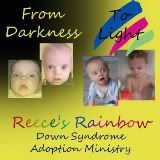Figured Day 21 would be a great day to post this…
Let's start with what it's all about: Trisomy 21. Chromosomes, those thready bits and pieces within us that are made of DNA and other proteins, in effect, making us who we are. Typical humans have 46 chromosomes, arranged in 23 pairs.
Sometimes, right at conception, little pieces of chromosomes get broken off, come missing, stick to each other or come in multiples, like twins or triplets. Trisomy 21 is that: an extra copy of the 21st chromosome.

The differences in Trisomy 21 lie in the type: there are 3 types:
- Standard Trisomy 21: when the extra chromosome comes from either the egg or sperm cell. Between 90-95% of all Trisomy 21 is Standard.
- Translocation: when a piece of chromosome 21 is located on another chromosome, such as chromosome 14. The person with Translocation Trisomy 21 will have 46 chromosomes but will have the genetic material of 47 chromosomes. People with Translocation Trisomy 21 and Standard Trisomy 21 look the same, have the same types of characteristics. Translocation occurs between 3-5% of cases of Trisomy 21.
Translocation is the only type of Trisomy 21 which may be inherited, and it may be inherited only if one of the parents is a carrier. A carrier will have 45 chromosomes instead of 46 but they will have all the genetic material of a person with 46 chromosomes. Remember that in Translocation Trisomy 21, the extra chromosome 21 material is on a different chromosome. A carrier will have the extra material but will have only one chromosome 21. The carrier will not have any of the characteristics of Trisomy 21 because they have the typical number of total chromosomes. Get it? Yeah, it can be confusing...
- Mosaicism: when a person has a mix of cells, some containing 46 chromosomes and some containing 47. A person with Mosaicism may have some, all or none of the characteristics of Standard Trisomy 21, depending on the percent of cells carrying the extra chromosome and where those cells are located on the genetic map. Mosaicism is rare, occurring in 2-5% of the population with Trisomy 21.
Standard Trisomy 21 is far and away the most common. And it's important to note that extra piece of genetic information is present in every*single cell of the body.
And so... since it's really Trisomy 21, why did it get the kind of off-putting name of "Down syndrome", leading to the "Down's" stuff, like um, "Down's kids" and "Down's babies" and "that Down's guy"?
Trisomy 21 got the syndrome slap-on when John Down published an essay in which he described children with common features who were distinct from others children in his English asylum. In this essay (which I have not read) he evidently made a stunning differentiation between "cretins" (- children with hypothyroidism) and "Mongoloids" (- named after Mongols, apparently because of the extra eye-fold that most people with Trisomy 21 have, lending them a gorgeously Asian glow).
****************
That's why it is. Usually just one tiny little chromosome that jumped on the boat and had some fun duplicating itself. Oh you spry little chromosome, you.
Taken from another fellow blogger (from here)













1 comment:
Hi. I changed my linky list on my blog to the blog hop that's going around. Would you add yours again? I'm sorry! I want her on it so much though (then you can get the code at the bottom and share it easily with your blog, too!)
Post a Comment